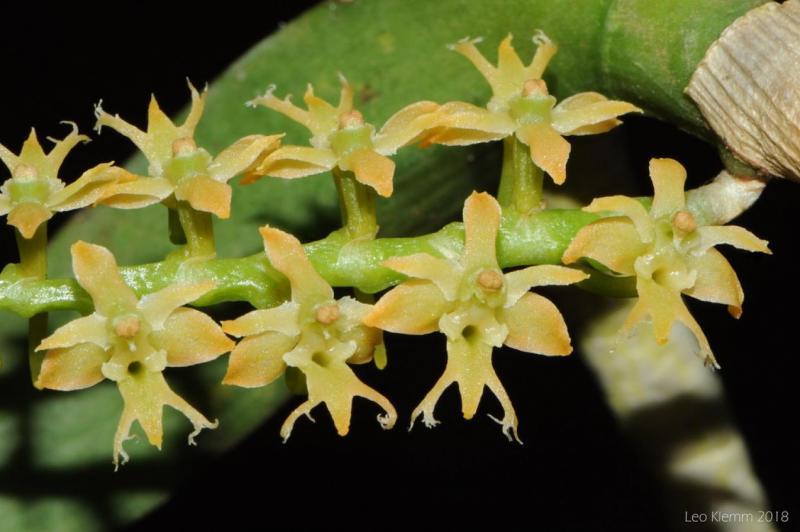Tridactyle bicaudata
Also known as: The Two or Tridactyle pulchella Tridactyle polychista Tridactyle fimbriata Rhaphidorhynchus fimbriatus Angraecum bicaudatum Angraecum fimbriatum Tridactyle bicaudata ssp. rupestris Tridactyle bicaudata ssp. bicaudata Listrostachys fimbriata Angraecum laciniatum Listrostachys cirrhosa in the subfamily: Epidendroideae
Native to: Burundi Cameroon Ghana Liberia Malawi Mozambique Nigeria Rwanda Uganda Zimbabwe
General Information
The Two is a large monopodial cool to hot growing epiphytic, lithophytic or terrestrial orchid belonging to the sub family Epidendroideae native to Burundi, Cameroon, Ghana, Liberia, Malawi, Mozambique, Nigeria, Rwanda, Uganda, and Zimbabwe.
Plant Description
Monopodial. Each new growth has numerous erect leaves
Flowers
Numerous fragrant blossoms appear during Summer
Fragrance
The orchid is fragrant.
Blooming Season
- Summer
Substrate(s)
- Coarse
- Bark
Care Notes
These orchids like to be kept on the dry side, but may need to be watered daily during warm weather, and prefer a well draining mix or also do well mounted, provided they can be watered regularly.
These are quite a forgiving orchid, there are no special requirements to get this orchid to flower, just good care and consistent conditions. Larger plants may be more fussy and can react poorly to change; a poorly timed repotting, a pest infection or an unusually hot day can set them back for a couple of years. However, even plants that have been treated poorly can thrive, and if they are set back they often recover much stronger then they would otherwise be.
Fragrant:- IsFragrant
Climate
Grows at high elevations.
Fertiliser
These plants do well with slow release fertiliser at the rate of 2-3 pellets per cup (250ml) of media. Additional fertiliser during the growth period may be beneficial, but not necessary.
Potting
These plants can be sensitive to repotting though should not require repotting regularly. Repotting should be done when the mix has broken down to the point that it doesn't absorb water or holds onto water for far too long, usually the plant shows a decline in growth as well.
The mix should be free draining, with a blend of 30% inorganic ingredients such as coarse sand, gravel or perlite, mixed in with about 70% organic ingredients such as peat, leaf litter or decomposed bark. Avoid commercial potting mixes as they can vary wildly and may contain "wetting agents" that can hold onto water for loo long, causing rotting and stunted growth.
This plant does very well in baskets or suspended pots









